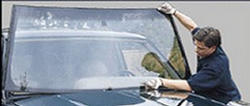Windshield Replacement
| Windshield Replacement Besides keeping the bugs out of your teeth, the windshield is a critical component of your car's safety system. As a safety device, its role is to stay in place and keep occupants inside the vehicle during impact. It is the backboard for the inflating passenger side air bag and provides crucial crush resistance support for the roof, in case of rollover. A replaced windshield must not compromise any safety standards that were part of the original vehicle design when your car rolled off the assembly line. Auto Glass is not "Just Glass" - Know the difference. On a new car, every part comes from the original equipment manufacturer (the OEM), including the windshield. For windshield replacement, you have the option to select a replacement made by a company that manufactures OEM windshields, such as PPG, or glass made from non-OEM manufacturers ("aftermarket glass"). Both OEM and aftermarket glass must comply with the Federal Motor Vehicle Safety Standards, but — there are two important OEM benefits: 1.An OEM replacement windshield is produced from original equipment-style tooling. This type of windshield will have the appearance of your car's original windshield and will fit properly in the window frame making noise and leakage problems much less likely. 2.OEM glass manufacturers partner with automobile producers to enhance overall functionality and improved performance. Because of their close work with car makers. OEM manufacturers have a greater knowledge of the engineering demands a car can place on the windshield and their replacement windshields are made using the same quality assurance systems as for new vehicles.
Windshields are made from a lamination process. A windshield actually consists of two pieces of glass, bonded together by a vinyl inter-layer. This vinyl layer cushions your head during impact. If a windshield breaks during impact, the broken pieces will generally adhere to the plastic lining. Side and rear windows consist of tempered glass, which is produced by heating the glass to more than 1,100°F and then rapidly cooling it. This results in the outside surfaces of the glass becoming harder than the center of glass and, therefore, is stronger than regular glass of the same thickness. Tempered glass will break-up into very small pieces, if broken. |
Four government Federal Motor Vehicle Safety Standards
(FMVSS) relate to automotive glass:
FMVSS 205 Glazing Materials - Standard 205 requires automotive manufacturers to label and use proper safety automotive glass in a motor vehicle. |
FMVSS 208 Occupant Crash Protection - Standard 208 specifies performance requirements for the protection of vehicle occupants, and encompasses all safety-related components, including the passenger-side air bag, which deploys into the windshield at 200 mph. |
FMVSS 212 Windshield Retention - Standard 212 states that a windshield must be retained in place during a frontal collision. Specific standards vary based on the use of seat belts and air bags. |
FMVSS 216 Roof-Crush Resistance - Standard 216 establishes structural strength standards to protect vehicle occupants during a rollover. The windshield provides vital support in this type of accident. If a windshield is not installed properly, it may come out of a vehicle during collision leading to serious injury. |
